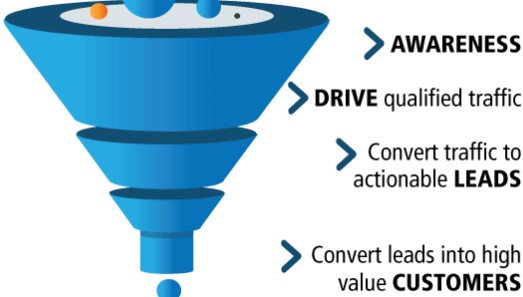Blog
Full Funnel Marketing: Stages and Examples

September 1st, 2021 by esigners
Leaders and marketers have provided a new life to the word full-funnel marketing. In the last year, numerous small and big organizations have traveled back to their basics for spurring sales and demand. Various have implemented and planned numerous funnel campaigns. Several client outreach professionals happen to be anticipating its enhanced role within business strategy. But, what does full-funnel marketing mean, and how exactly does it work out? Let us delve deeper into the stages and examples of full-funnel marketing.
What is full-funnel marketing and what are its stages?
Funnel in full-funnel marketing terminology happens to be a customer outreach strategy for understanding every step of the client journey starting from when they initially come across a brand or business until they turn out to be a customer. This idea is usually acknowledged as a funnel including a broad entry that goes on narrowing with every progressive step. Maximum professionals agree that there happen to be three primary stages of this funnel.
Awareness: The initial step of full-funnel marketing that attracts new clients according to their challenges, unique preferences, or interests. The concentration of this stage happens to generate awareness within audiences who are not well known of the brand.
Consideration: After the attention has been caught, the subsequent step is placing the brand as a suitable option over other services and products by highlighting their USPs. The purpose of this step is to communicate the benefits and strengths of buying the service or product.
Conversion: This is the ultimate stage of the funnel that is provided to convert possible customers into active ones. Generally, it is done in the form of a call to action, hence leading to communications with the core processes of the organization directly.
As far as newer models are taken into consideration, another stage like desire comes between consideration and conversion. This helps argue that a particular set of tactics and practices are required to make services and products desirable according to the client base. Similarly, others had the stage known as retention that helps insist that after a lead has been converted, continuous effort is required to maintain the base of loyal customers.
Example of full-funnel marketing
The idea of full-funnel marketing has been the foundation of client outreach marketing efforts as well as campaigns for a long time. But, the value was re-established throughout the covid-19 pandemic that attempted a huge part of the population to thrive, purchase, consume and live differently.
Well-established marketing and sales processes that assisted companies in maintaining a steady plan happen to be disrupted and modifying client priorities indicated that they happen to be more willing to attempt trying new products. In these transformations, businesses throughout the globe understood that they are required to revamp their strategies of funnel marketing according to the changing trends and customer preferences.
Other than that, the endless advantages of full-funnel marketing like improving business, reaching a broader audience, boosting customer retention and acquisition as well as improving brand awareness make it pretty lucrative for businesses. Therefore, to conclude, it can be said that a full-funnel marketing strategy can be implemented, measured, and contextualized utilizing a plethora of easily accessible tools.

